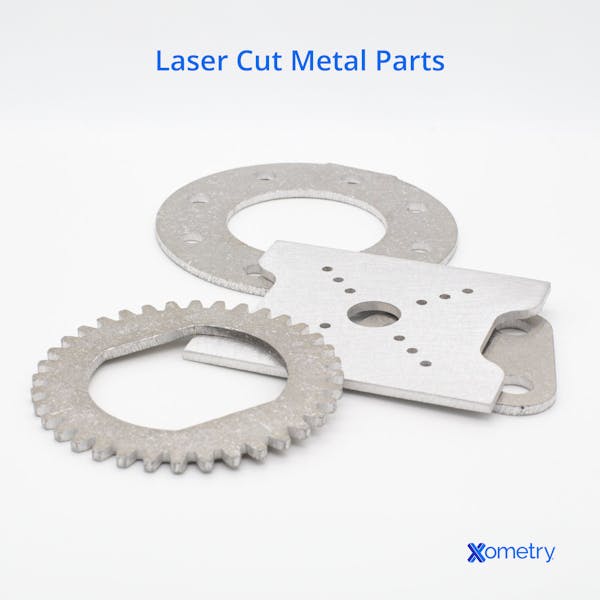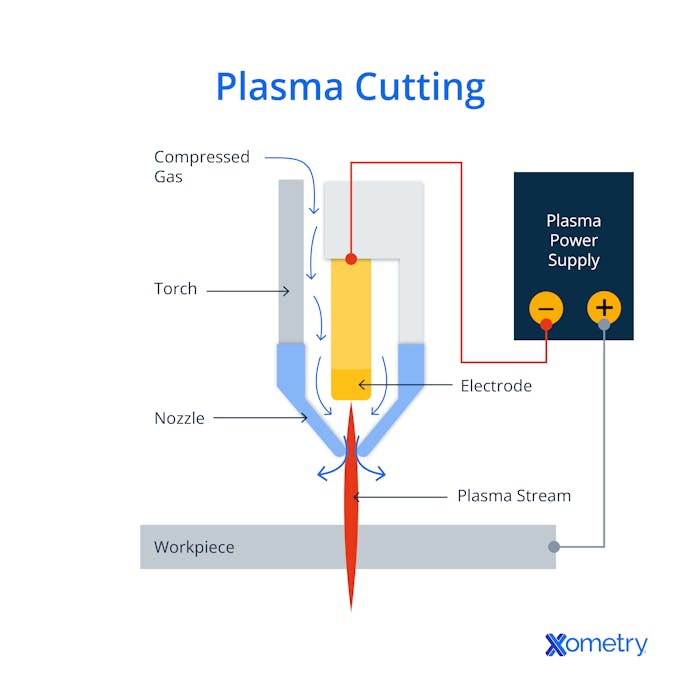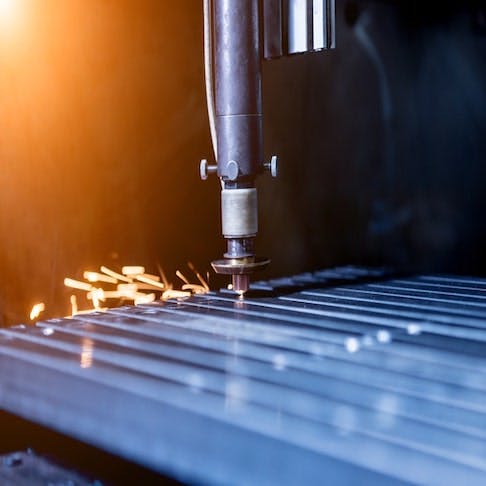Both laser and plasma cutting are computer numerical control (CNC) cutting processes Xometry offers via our sheet metal cutting services. They’re useful for thermally cutting different types of materials and are used in many different industries. Although similar, they have a few important differences, which we’ll cover in this article.
What is Laser Cutting?
Laser cutting allows cuts through a material with a concentrated laser beam that melts and separates a local part of it. In most cases, the process will be accompanied by a gas that blows the melted material out of the way, or the freshly cut material will be turned from a solid to a gas (called sublimation), also getting it out of the way, but this time in vapor form. Laser cutting is quite versatile, as it can be used to cut structural and pipe materials in addition to thin sheets. At Xometry, we use laser cutting most often when it comes to cutting sheet materials.
There are three main types of lasers you can use for laser cutting—they all basically do the same thing, but some are better for thicker materials. They are CO2, neodymium, and fiber laser systems:
- CO2 cutters, the most popular of the three, use electrically stimulated CO2. They’re versatile, inexpensive, and don’t need a lot of power.
- Neodymium cutters, also known as crystal laser cutters, use Nd: YVO (neodymium-doped yttrium ortho-vanadate) to produce the beam.
- Fiber cutters use fiberglass to cut through surfaces. Some special fibers are then used to amplify the seed laser, and this is what creates the final beam.
Laser cutting is used almost everywhere, from electronics to medicine, and aircraft to transportation. It’s also a great way to get precise cuts and finishes, and that’s why many Xometry customers opt for laser cutting when it comes to materials like tungsten, steel, aluminum, brass, and nickel. But it can also cut non-metals like silicon, wood, and ceramics. Here are what some laser-cut piece from aluminum can look like:

What is Plasma Cutting?
Unlike laser cutting, plasma cutting forces a hot, electrically charged gas like argon or nitrogen through a small nozzle. It hits the surface with speed and high pressure, essentially melting and eroding the material as it passes through. The similarity, however, is that, like laser cutting, plasma cutting is a thermal cutting process because the plasma it forms can reach up to 20,000°C.
With plasma cutting, you can only use conductive metals like steel, stainless steel, and copper, because these complete the electrical circuit. That’s why most of our customers who use plasma cutters are often in sectors like auto repair and restoration, fabrication shops, and industrial construction. This diagram breaks down the plasma-cutting process:


Comparing Laser Cutting vs. Plasma Cutting
The main area where these two cutting processes differ is their power source. Laser cutting machines cut through materials using a narrow and intense ray of light, but plasma cutters emit a directed flow of plasma instead. Both methods are mainly used to cut metals, but laser cutting can also be used for cutting other materials, like ceramic and wood. The below side-by-side comparison table offers a more in-depth look at their differences.
| Comparison | Laser Cutting | Plasma Cutting |
|---|---|---|
Comparison Accuracy | Laser Cutting It’s more accurate than plasma cutting and concentrates on a tiny area. This makes its cuts smoother, too. | Plasma Cutting It’s not as accurate as laser cutting and produces a larger seam and slightly rougher cuts which may need to be ground down. |
Comparison Speed | Laser Cutting It’s faster and more energy efficient than plasma cutting. | Plasma Cutting Plasma cutting takes longer than laser cutting. |
Comparison Materials | Laser Cutting It can cut through various materials like metal, wood, ceramics, and plastics. | Plasma Cutting It’s limited to conductive materials. |
Comparison Reflective material compatibility | Laser Cutting Although it’s fine for a variety of materials, it’s not as good as plasma cutting for reflective materials like metal. | Plasma Cutting It’s better at cutting reflective materials. |
Comparison Sheet thickness | Laser Cutting It will struggle with anything thicker than 19mm but can cut 12.7mm thick aluminum, 19mm thick stainless steel, and 25.4mm thick steel. | Plasma Cutting This can cut through metal sheets up to half an inch (38mm) thick. |
Comparison Cutting surface | Laser Cutting The cutting surface is smooth, with good cut quality and no burrs — ideal for detailed designs. | Plasma Cutting It’s known to have poor perpendicularity, making cuts with more cutting slag that needs to be removed by grinding. |
Comparison Slot widths | Laser Cutting It makes cuts with very narrow slot widths of approximately ±0.15mm and high precision of 0.01mm or less. | Plasma Cutting It has a larger slot width (larger than 3.8mm) and a precision of about 0.5–1mm. |
Comparison Cost | Laser Cutting Laser cutters are generally way more expensive. In addition to the capital investment, they are usually more expensive to run, too. | Plasma Cutting Plasma cutters are cheaper to buy and operate. |
Comparison Maintenance | Laser Cutting Laser cutters normally need more maintenance. | Plasma Cutting Less maintenance is needed compared to laser cutters. |
Comparison Kerf size | Laser Cutting Laser cutters, being more precise, produce a small kerf (the size of the seam). | Plasma Cutting Plasma cutters make a larger seam, or kerf, because they’re not as specific and precise. |
Comparison Radiation levels | Laser Cutting Laser cutters don’t really produce any radiation. | Plasma Cutting Plasma cutters actually create radiation, so they can be more dangerous. Wear protective equipment when using the machine. |
Comparison Additional functions | Laser Cutting Laser cutters can usually also engrave. | Plasma Cutting Plasma cutters can’t engrave, so they’re pretty much only used for cutting. |
Laser Cutting vs. Plasma Cutting Comparisons
Greg Paulsen, the director of applications engineering here at Xometry advises, “For sheet cutting services, we almost always use lasers over plasma because of its superior detail resolution. Plasma cutting is lower cost, and works very well for items that you are welding together because you can sand or grind the edge condition.”
If, after reading this article, you decide that neither laser cutting nor plasma cutting is right for you, you can consider alternative methods like water jet cutting, oxy-fuel cutting, or wire EDM (electrical discharge machining).
How Xometry Can Help
Xometry provides a wide range of manufacturing capabilities, including sheet cutting and other value-added services for all of your prototyping and production needs. Want to learn more about our custom CNC cutting services, and get an instant quote? A Xometry representative is always available to help.
Disclaimer
The content appearing on this webpage is for informational purposes only. Xometry makes no representation or warranty of any kind, be it expressed or implied, as to the accuracy, completeness, or validity of the information. Any performance parameters, geometric tolerances, specific design features, quality and types of materials, or processes should not be inferred to represent what will be delivered by third-party suppliers or manufacturers through Xometry’s network. Buyers seeking quotes for parts are responsible for defining the specific requirements for those parts. Please refer to our terms and conditions for more information.


